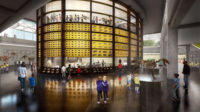In the wake of several failures to preserve well known Brutalist buildings around the nation, preservationists in Baltimore are readying themselves for an August 14th hearing that will decide the fate of this city’s own cast-concrete progeny. The Morris Mechanic Theater, designed by John Johansen, will come before a public hearing at the Baltimore Commission for Historical and Architectural Preservation (BHAP) for the recommendation of Baltimore City Landmark status; the meeting will also set a six-month delay on new construction permits at the building’s site.


Photos: Courtesy Michael V. Murphy
Architect John Johansen’s 1967-vintage Morris Mechanic Theater, in Baltimore, is threatened with substantial alteration. Its fate could be decided at a public hearing on August 14.
The Mechanic Theater opened in January 1967 as the rough-hewn crown jewel of Baltimore’s downtown revitalization efforts. Johansen studied design at Harvard and spent his early career days in the office of Marcel Breuer. Like much of its Brutalist ilk, the Mechanic’s architecture—known in an academic capacity as “abstract expressionism”—often draws criticism for its angular concrete forms.
“They call it Brutalist architecture, I call it a mistake,” says Melvin Greenwald, who owns the Mechanic with his son Benjamin. “It’s ugly. I don’t know anyone that likes it. The building was obsolete when they built it.”
The Greenwalds, who already owned a subterranean parking garage at the site, purchased the abandoned Mechanic for $6 million in 2005. The 1,614-seat theater had sat vacant since 2004, when the nearby Hippodrome Theater reopened after extensive renovations financed by Clear Channel Entertainment. The refurbished 1911-era structure seats 2,286 people and now snags all the Broadway productions that pass through Baltimore—productions that its neighbor had previously premiered. The Greenwalds’ proposed redevelopment would add a level of retail space above the existing Mechanic structure as well as a 10-story residential tower.
“It has no purpose as a theater, it’s just inadequate,” Greenwald says. Noting that he has already removed the stage floor and stripped the interior of “all semblances of the theater,” he adds “there is no historic integrity to the building.”
But plenty of observers disagree with this assessment. “It’s a very important building for our city—it shows civic pride and progress at a certain time,” says Michael V. Murphy, AIA, who is an appointed member of BHAP. “Our job is to identify the very best work of each generation, I think it would be a tragedy to lose this building. When it was new, it was truly avant-garde.”
Efforts to preserve the structure have received support from both the Baltimore chapter and national component of the American Institute of Architects, Docomomo, and the Recent Past Preservation Network (RPPN), which plans to create an informational Web site devoted to the building and its architect.
“Brutalism is really the new frontier for preservation, and preservationists,” observes RPPN president Christine Madrid French. “We often ask ourselves how can we show these cities that these structures matter so much.”
Acknowledging that the Mechanic is no longer a functioning theater, preservationists contend that it should be adapted for a new use with careful additions and renovation. “There are appropriate ways to add to the building that can be complimentary,” says Kathleen Kotarba, the executive director of BHAP. If her group approves landmark status for the building at next week’s hearing, the case will move to Baltimore’s planning commission and ultimately to the city council for final approval.




Post a comment to this article
Report Abusive Comment